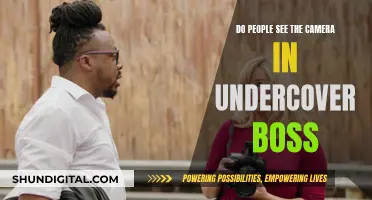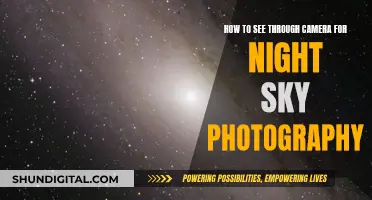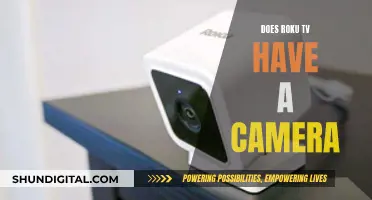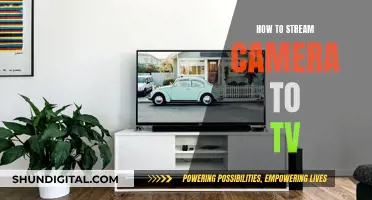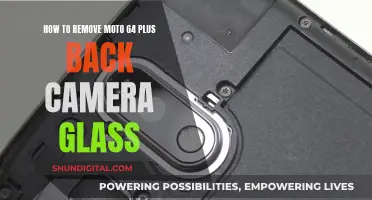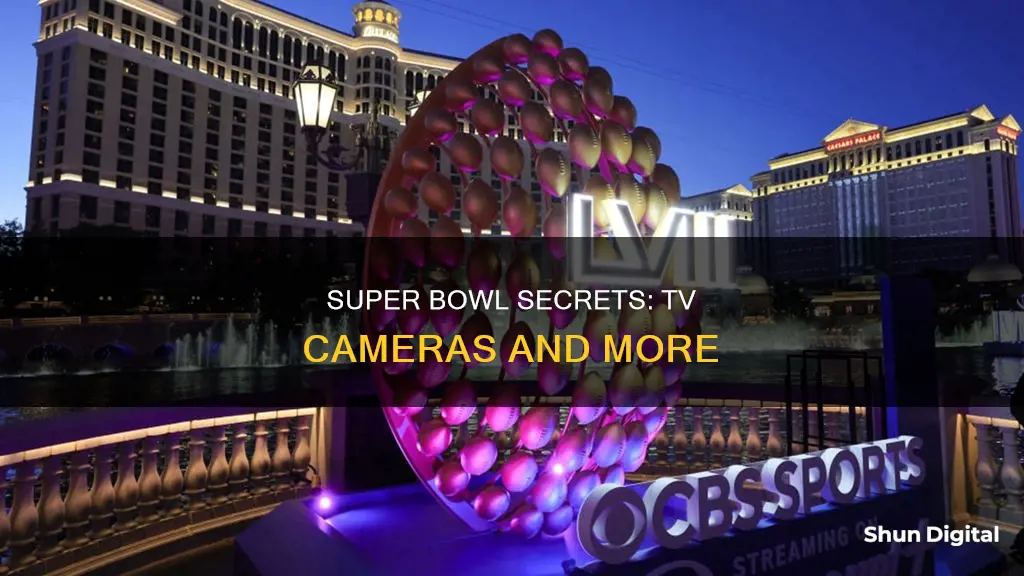
Capturing the Super Bowl on TV is a massive undertaking. CBS's Super Bowl 55 broadcast, for example, featured 120 cameras stationed around the stadium, including two Sony Venice cameras, a Trolley Cam, a Movie Bird Crane, and twelve cameras with 4K and 8K capabilities. For Super Bowl LVIII, CBS Sports upped the ante, employing a total of 165 cameras, 48 of which had super slow-motion capabilities, and introducing the Doink Camera, which provided unprecedented angles of field goals and extra points.
What You'll Learn

CBS's Super Bowl 55 cameras included movie-like end zone shots and a Trolley Cam
CBS's Super Bowl 55 camera setup included movie-like end zone shots and a Trolley Cam, marking a new direction for the network's NFL coverage. The setup was CBS's take on Fox's camera trend-setting during the 2020 NFL season, where they introduced a Sony DSLR camera to create a cinematic feeling for its end zone celebration shots.
CBS's version consisted of two Sony Venice cameras, which were operated on a traditional stedi-cam rig, along with a MOVI rig. The unique visual effect of this camera impacts the depth-of-field, with players in focus appearing crystal clear while the background blurs, creating a movie-like effect compared to the Madden NFL video game series.
The Trolley Cam was one of four flying camera systems used by CBS for Super Bowl 55. It sped from one end of the stadium to the other, zipping along a wire at up to 65 mph, providing a viewing angle similar to that of a fan in the eighth row of the stands.
In addition to the Trolley Cam and the two Sony Venice cameras, CBS also utilised a "Movie Bird Crane", normally reserved for major motion pictures, to capture dramatic sweeping shots of the pregame set and game action. They also scattered 12 cameras with 4K and 8K capabilities throughout the stadium to capture close-up shots of key moments.
CBS's innovative camera choices for Super Bowl 55 added up to more than 120 cameras stationed around the Raymond James Stadium in Tampa, offering viewers a truly unique and immersive experience of the game.
The Privacy Paradox: Cameras in Suicide Watch Cells
You may want to see also

There were 165 cameras used for Super Bowl LVIII
The 165 cameras included 48 with super slow-motion capabilities, 24 4K zoom extraction cameras, six 'doink' cameras in the uprights, three sky cams, two fly cams (including a 'trolley cam'), and three drones. There were also 23 augmented reality cameras in use, 11 of which were used during the CBS broadcast, eight during the Nickelodeon alternative broadcast, and four at the network's set at the Fountains of Bellagio.
The introduction of the 'doink' camera enabled CBS to capture unprecedented angles of field goals and extra points. The 'doink' cameras were attached to the uprights in both end zones, each facing the field at different angles. This provided a unique perspective of the kicks and allowed for a closer look at the game's most crucial plays with higher resolution and enhanced detail.
The use of so many cameras, along with other innovative technologies, ensured that Super Bowl LVIII was a visually spectacular event for viewers around the world.
Pairing Apple Watch with Camera: A Simple Guide
You may want to see also

Cameras with super slow-motion capability
CBS Sports utilised 48 cameras with super slow-motion capabilities for Super Bowl LVIII. These cameras were set up in and around Allegiant Stadium in Las Vegas, as well as at the network's Super Bowl television set at the Fountains of Bellagio.
The super slow-motion cameras provided different angles inside the stadium, including from the ceiling, along the goal lines, and embedded inside the end zone pylons. The enhanced 4K zoom allowed for better replay capabilities and gave officials a closer look at the game's most crucial plays, with higher resolution and enhanced detail.
The super slow-motion cameras were also used to capture the build-up to the game, the half-time show, and the interview areas. They provided viewers with a unique perspective of the event, showcasing the atmosphere and excitement of the Super Bowl.
The super slow-motion technology is a significant advancement in sports broadcasting, allowing for an incredibly detailed analysis of the game and providing viewers with an immersive and engaging viewing experience.
Uniden Camera Viewing: A Step-by-Step Guide
You may want to see also

The debut of the 'Doink Camera'
The debut of the Doink Camera
The Super Bowl is one of the most-watched sporting events in the world, with millions tuning in to watch the biggest game in American football. So, it's only fitting that the event is at the forefront of broadcasting innovation.
For Super Bowl LVIII, CBS Sports introduced a record number of cameras to capture the action, with a total of 165 cameras deployed across the network. Among these was the debut of the "Doink Camera", a small camera embedded inside the field goal uprights. With six 4K "Doink Cameras" in total, viewers were treated to unprecedented, unique angles of field goals and extra points.
The name "Doink" comes from the cartoonish sound a football makes when it hits the upright six-inch aluminum posts of the goalposts. The inspiration for the camera came from the previous year's Super Bowl when Kansas City Chiefs kicker Harrison Butker hit one of the goalposts during his first field goal attempt.
The "Doink Cameras" were positioned at different angles, allowing for a variety of perspectives of the kicks. They also had high-resolution zoom capability and were available for super slow-motion replays, offering viewers a truly immersive viewing experience.
The debut of the "Doink Camera" marked a significant step forward in sports broadcasting, providing fans with a whole new way to experience the Super Bowl and further enhancing the excitement and drama of the game.
Smartwatches with Cameras: Innovative Timekeeping
You may want to see also

Cameras with 4K and 8K capabilities
When it comes to the Super Bowl, it's no surprise that broadcasters want to utilise the best technology available to capture this highly anticipated sporting event. For Super Bowl LVIII, CBS Sports plans to use an impressive 165 cameras, including 48 with super slow-motion capabilities. Out of these, 24 will be 4K zoom extraction cameras, which is a record for the Super Bowl. This means that viewers at home will be able to experience the game in incredible detail, with enhanced replay capabilities and a closer look at the most crucial plays.
In addition to the 4K cameras, CBS will also be using unique camera setups to capture the Super Bowl from new and exciting angles. This includes the "Trolley Cam", which will speed from one end of the stadium to the other, providing a viewing angle similar to that of a fan in the eighth row. Another innovative camera is the "Doink Camera", which will be placed in the uprights of both end zones to capture unprecedented angles of field goals and extra points.
With the constant advancements in camera technology, it's no surprise that 8K cameras are starting to make an appearance at the Super Bowl. For Super Bowl 55, CBS used two Sony Venice cameras, which are capable of capturing unique, movie-like shots with a shallow depth of field. This effect, often compared to the Madden NFL video game series, adds a cinematic feel to the broadcast and enhances the viewing experience for fans.
While 8K cameras may not yet be as prevalent as their 4K counterparts, it's clear that they are starting to gain traction in the industry. As technology continues to evolve and 8K becomes more accessible, we can expect to see even more 8K cameras at future Super Bowls, providing viewers with an even more immersive and detailed viewing experience.
Apple Watch Camera Models: Which Ones Have It?
You may want to see also
Frequently asked questions
The number of cameras used at the Super Bowl varies. For Super Bowl 55, CBS used 120 cameras. For Super Bowl LVIII, CBS used 165 cameras.
The types of cameras used at the Super Bowl vary. For Super Bowl 55, CBS used two Sony Venice cameras, a "Trolley Cam", and a "Movie Bird Crane". For Super Bowl LVIII, CBS used 48 cameras with super slow-motion capabilities, 24 4K zoom extraction cameras, six "Doink" cameras, three sky cams, two fly cams, three drones, and 23 augmented reality cameras.
A "Trolley Cam" is a camera that speeds from one end of the stadium to the other, ziplining along a wire at up to 65 mph. It provides a unique viewing angle of the players from the perspective of a fan in the eighth row of the stands.
A "Doink" camera is placed in the upright of the end zones, capturing unprecedented angles of field goals and extra points.



